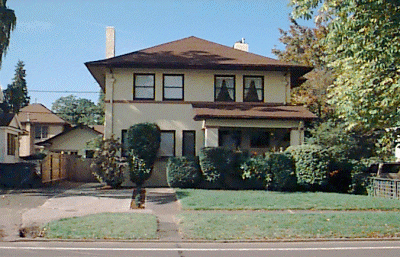Historic Walking Tour - George Whiteside House
Significance
The George Whiteside House, with its intact design is architecturally significant as the best example, albeit late, of a house with Prairie style influence in the survey area. The house is also constructed "using stone tile", a building material which was new to the Corvallis area in the mid-1920's, and as such is one of the only houses to incorporate this material for construction in the survey area. Houses of this material were built in other parts of Corvallis.
The house is historically significant for its association with George Whiteside, pioneer of the theater business in Corvallis.
Physical Description
Stylistically, the George Whiteside House is a late local variant of the Prairie Style. Prairie Style influence is evident in the house's horizontal emphasis, lack of ornamentation, stucco siding, gently pitched hipped roof, and the wide, slightly flaring eaves. Square in plan, the house is constructed of ""stone tile"" with exterior walls covered with stucco . A one-story entry porch is located on the main facade off-center to the north. The porch features two large square columns with simple capitals supporting a shed roof. The eaves of the porch roof overhang and return on the north and south elevations. A rear porch, also located off-set center to the north, repeats this eave detail. The rear porch is closed in today. The single leaf entry door is fully glazed.
Exterior doors and windows are recessed and are not trimmed. Windows are one-over-one, double-hung sash windows sometimes grouped two a bay. The main facade features a wide fixed sash window flanked by two narrow single-sash windows.
Exterior wall treatment of the house is plain with the exception of a water table located below the second story windows, which adds to the feeling of horizontality. An exterior brick fireplace chimney, coated with stucco, is located on the south elevation. There is also a wide interior chimney of stucco-coated brick. Although the house serves as a multiple-family residence today, the interior retains many original elements.
Historical Background
This house was built for George and Lillian Ranney Whiteside by Earl Heckart, a local contractor, in 1925. The cost of the house was $12,000.
Lillian Ranney and George Whiteside were married on October 17, 1914. Lillian Whiteside is the daughter of early Benton County Pioneers Titus and Ella Ranney. George Whiteside is the son of Samuel and Sarah Whiteside. He was born near Burlington, Iowa, on July 19, 1874. He moved to Corvallis with his parents in 1891 locating on the old Rufus Skipton Ranch eight miles southwest of Corvallis.
After operating a transfer business with his brothers in Corvallis, he opened a shoe store with Samuel Whiteside. George and Samuel Whiteside then pioneered the moving picture business in Corvallis operating the Palace Theatre on 2nd Street shortly after the turn of the century. Other theatres operated by the Whitesides included the Crystal Theatre in the Masonic Building on 2nd Street, and the Majestic Theatre which opened in 1913 in the Johnson Porter Building. In the early 1920's, the Whitesides built the Whiteside Theatre on Madison Street still in operation today under the same name.
Lillian Whiteside died in 1935 and in 1936 George Whiteside married Carrie Leedy Hartsock, the widow of S.K. Hartsock. George Whiteside died in 1954 but his wife continued to occupy the current house until the 1960's.
Sources Consulted
- Benton County Deed Registry.
- Browning, Elsie Bennett, Oregon--Benton County Marriages 1851-1922, E.L.S. Brown, Salem, Oregon, 1981.
- Gazette-Times, Corvallis, Oregon, Feb. 18, 1925.
- Gazette-Times, Corvallis, Oregon, March 12, 1925.
- Gazette-Times, Corvallis, Oregon, Jan. 2, 1935.
- Gazette-Times, Corvallis, Oregon, March 22, 1954.
